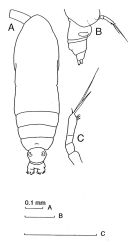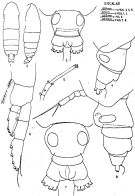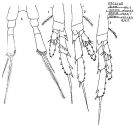|
|
 |
Fiche d'espèce de Copépode |
|
|
Calanoida ( Ordre ) |
|
|
|
Calanoidea ( Superfamille ) |
|
|
|
Paracalanidae ( Famille ) |
|
|
|
Calocalanus ( Genre ) |
|
|
| |
Calocalanus neptunus Shmeleva, 1965 (F,M) | |
| | | | | | | Ref.: | | | Shmeleva, 1965 c (p.8, figs.F,M); 1967 a (p.1177, figs.F,M); Corral Estrada, 1970 (p.121, figs.F); 1970 a (p.13, figs.F); Corral, 1972 (n°138, p.4, 5, figs.F,M); Bradford-Grieve, 1994 (p.58, figs.F,M, fig.99); Avancini & al., 2006 (p.69, Pl. 38, figs.F,M, Rem.); Vives & Shmeleva, 2007 (p.946, figs.F,M, Rem.) |  issued from : J.M. Bradford-Grieve in The Marine Fauna of New Zealand: Pelagic Calanoid Copepoda. National Institute of Water and Atmospheric Research (NIWA). New Zealand Oceanographic Institute Memoir, 102, 1994. [p.59, Fig.30]. Female: A, habitus (dorsal); B, last thoracic segment and urosome (lateral right side); C, P5. Nota: The Southwest Pacific females appear to be similar to the Adriatic specimens, but differ in that the head and pedigerous 1 appear to be fused and there is an indication, in the midline, of fusion between pedigerous segments 4 and 5.
|
 issued from : J. Corral Estrada in Tesis Doct., Univ. Madrid, A-129, Sec. Biologicas, 1970. [Lam.31]. Female (from Canarias Is.): 1, habitus (dorsal); 2, idem (lateral left side); 3, urosome (dorsal); 4, idem (lateral left side); 5, distal segments of A1; 6, P1; 7, urosome (dorsal (another specimen); 8, posterior part cephalothorax with P5 and urosome (lateral left side).
|
 issued from : J. Corral Estrada in Tesis Doct., Univ. Madrid, A-129, Sec. Biologicas, 1970. [Lam.32, figs.1-4]. Female: 1, P2; 2, P3; 3, P4; 4, P5.
|
 issued from : A.A. Shmeleva in Zool. Zh., 1967, 46 (8). [p.1178, Fig.3]. Female (from Ionian Sea): 1, habitus (dorsal); 2, urosome (dorsal); 3, rostrum (lateral); 4-8, P1 to P5. Nota: Head and 1st pedigerous somite separate, 4th and 5th pedigerous somites fused. Rostrum well developed, bifurcated. A1 slightly exceeding the body length; 24-segmented, the last one almost 2.5 times longer than the penultimate. P5 3-segmented, symmetrical, the last segment is 2.5 times longer than the preceding one, armed with 2 massive terminal setae, the inner being more than twice as long as the outer one, at the base of these seta there is a crown of small spinules.Genital segment oval, convex in ventral view, with a very well distinguished spherical spermathecae. Anal somite large, almost 3 times as long as the preceding one and 2 times as long as the caudal ramus. Symmetrical furca, short and movable, its length about twice as large as wide, 4 strong setae on each caudal ramus Male: 9, habitus (dorsal); 10, urosome (dorsal); 11, rostrum (lateral); 12, P1; 13, P4; 14, P5. Nota: The male looks like the female. Head and 1st pedigerous somite fused. Urosome 5-segmented. Anal somite of the same length as the two preceding ones. Caudal rami immovable, slightly asymmetrical, equaling in length to the anal somite, each ramus with 4 strong and 1 fine, inner seta. P5 asymmetrical, the left leg 4-segmented (1.6 times longer than the right leg), the right leg 3-segmented, both armed with small terminal spinules
| | | | | Ref. compl.: | | | Apostolopoulou, 1972 (p.327, 340); Corral Estrada & Pereiro Muñoz, 1974 (tab.I); Kovalev & Schmeleva, 1982 (p.83); Vives, 1982 (p.290); Scotto di Carlo & al., 1984 (1043); Greze & al., 1985 (p.7); Lozano Soldevilla & al., 1988 (p.57); Siokou-Frangou, 1997 (tab.1); Hure & Krsinic, 1998 (p.20, 100); Vukanic, 2003 (139, tab.1); Isari & al., 2006 (p.241, tab.II); Mazzocchi & Di Capua, 2010 (p.426); Isari & al., 2011 (p.51, Table 2, abundance vs distribution); Uysal & Shmeleva, 2012 (p.909, Table I); Lidvanov & al., 2013 (p.290, Table 2, % composition); Mazzocchi & al., 2014 (p.64, Table 5, abundance); Benedetti & al., 2016 (p.159, Table I, fig.1, functional characters); Belmonte, 2018 (p.273, Table I: Italian zones) | | | | NZ: | 5 | | |
|
Carte de distribution de Calocalanus neptunus par zones géographiques
|
| | | | | | | | | | Loc: | | | Canary Is., off Morocco-Mauritania, W Gibraltar, Medit. (Alboran Sea, Ligurian Sea, Tyrrhenian Sea, Gulf of Sidra, Ionian Sea, Adriatic Sea, Aegean Sea, Thracian Sea, Izmir Bay, Lebanon Basin), Red Sea, Indian, New Zealand | | | | N: | 23 | | | | Lg.: | | | (180) F: 0,96-0,84; (196) F: 0,88-0,84; (428) F: 0,91-0,84; M: 0,84-0,81; {F: 0,84-0,96; M: 0,81-0,84} | | | | Rem.: | épipélagique-?
Voir aussi les remarques en anglais | | | Dernière mise à jour : 06/02/2020 | |
|
|
 Toute utilisation de ce site pour une publication sera mentionnée avec la référence suivante : Toute utilisation de ce site pour une publication sera mentionnée avec la référence suivante :
Razouls C., Desreumaux N., Kouwenberg J. et de Bovée F., 2005-2025. - Biodiversité des Copépodes planctoniques marins (morphologie, répartition géographique et données biologiques). Sorbonne Université, CNRS. Disponible sur http://copepodes.obs-banyuls.fr [Accédé le 03 décembre 2025] © copyright 2005-2025 Sorbonne Université, CNRS
|
|
 |
 |







